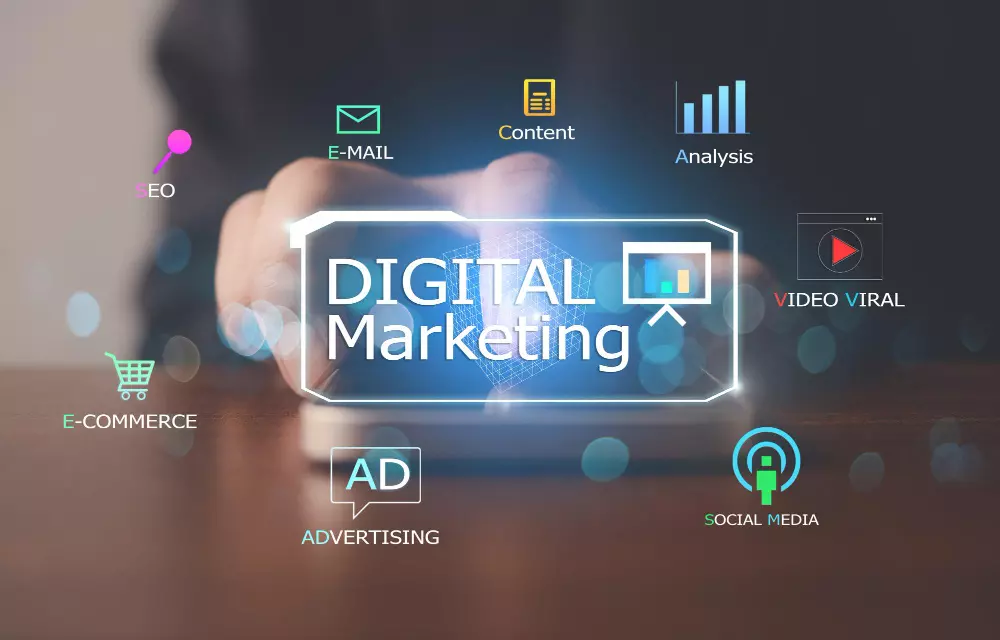Digital marketing is a powerful tool for businesses to connect with their target audiences and achieve their marketing goals. However, to gauge the success of their digital marketing campaigns, companies need to understand how to measure their performance.
Businesses can employ various types of digital marketing campaigns to achieve different objectives and reach their target audience.
Types of Digital Marketing Campaigns:
Businesses can employ various types of digital marketing campaigns to achieve different objectives and reach their target audience.

Here are different types of digital marketing campaigns:
- Search Engine Optimization(SEO)
- Pay Per Click
- Social Media Marketing
- Content Marketing
- Email Marketing
- Influencer Marketing
- Affiliate Marketing
- Display Advertising
- Remarketing campaigns
- Mobile Marketing
Search Engine Optimization (SEO):
SEO campaigns optimize a website’s visibility in search engine results pages (SERPs). The goal is to improve organic (unpaid) search rankings by optimizing website content, keywords, and technical aspects to increase website traffic and visibility.
With Crimson Cobalt’s expert SEO services, businesses can effectively boost their online visibility and drive significant organic traffic to their websites. By implementing proven strategies and leveraging the latest digital marketing techniques, Crimson Cobalt empowers businesses to stay ahead in the competitive online landscape and achieve sustainable growth. For more updates, contact us and follow our LinkedIn profile.
Pay-per-Click (PPC) Campaigns:
PPC campaigns involve placing paid advertisements in search engine results or on other websites. Advertisers pay a fee each time their ad is clicked. PPC campaigns can provide immediate visibility and drive targeted traffic to a website.
Social Media Marketing:
These campaigns leverage social media platforms like Facebook, Instagram, Twitter, and LinkedIn to engage with target audiences. They typically involve creating and sharing content, running paid advertising, and fostering community engagement.
Content Marketing:
Content marketing campaigns revolve around creating and distributing valuable, relevant, and engaging content to attract and retain a target audience. They can include blog posts, articles, videos, infographics, eBooks, etc. The objective is to build brand awareness, establish thought leadership, and drive customer engagement.
Email Marketing:
Email marketing campaigns involve sending targeted emails to a segmented list of subscribers. These campaigns nurture leads, drive conversions, and build customer loyalty. Email campaigns can include newsletters, promotional offers, personalized recommendations, and automated email sequences.
Influencer Marketing:
Influencer marketing campaigns involve collaborating with influential individuals or content creators with a significant following and credibility within a specific niche or industry. Brands partner with influencers to promote their products or services to their engaged audience, leveraging their influence and trust.
Affiliate Marketing Campaigns:
Affiliate marketing campaigns involve partnering with affiliates who promote a business’s products or services and earn a commission for each referred sale. This type of campaign can help expand reach, drive sales, and increase brand exposure through a network of affiliates.
Display Advertising:
Display advertising campaigns involve placing banner ads or interactive media on websites, apps, or social media platforms. These campaigns aim to generate brand awareness, drive traffic, and capture leads by targeting specific audiences based on demographics, interests, or browsing behavior.
Remarketing Campaigns:
These campaigns target users who have previously interacted with a website or shown interest in specific products or services. Through cookies, targeted ads are displayed to these users as they browse other websites or platforms, reminding them of the brand and encouraging conversions.
Mobile Marketing:
These campaigns focus on reaching users on their mobile devices through various channels, including mobile apps, SMS marketing, in-app advertising, and mobile search ads. These campaigns cater to the growing number of users accessing the internet and engaging with content through mobile devices.
How to choose your digital marketing campaign?
Choosing the right digital marketing campaign for your business involves considering several factors. Here’s a step-by-step guide to help you make an informed decision:
- Define your goals: Start by clearly identifying your business objectives. Do you want to increase brand awareness, generate leads, drive website traffic, boost sales, or improve customer retention? Understanding your goals will help you align them with the most suitable campaign types.
- Understand your target audience: Develop a deep understanding of your target audience, their preferences, online behavior, and the platforms they frequent. This knowledge will guide you in selecting the channels and campaign types that effectively reach and engage your audience.
- Evaluate your resources: Assess your available resources, including budget, time, and expertise. Certain campaigns may require significant financial investment or specialized skills, while others may be more cost-effective and manageable for smaller businesses. Consider what resources you can allocate to your digital marketing efforts.
- Research campaign options: Familiarize yourself with the types of digital marketing campaigns available and their benefits. Research case studies, success stories, and industry best practices to understand how various campaigns have worked for businesses similar to yours.
- Consider your industry and competition: Analyze your industry landscape and competitive environment. Look at what digital marketing strategies and tactics your competitors are employing. While it’s important to stay competitive, also explore opportunities to differentiate yourself by selecting campaign types that are less saturated or more suitable for your niche.
- Analyze past performance: Assess any previous digital marketing efforts you’ve undertaken. Look at the results, insights, and lessons learned from past campaigns. Determine which strategies and tactics yielded the best outcomes and consider leveraging or expanding upon them.
- Seek expert advice if needed: If you’re unsure about the best campaign type for your business, consider consulting with digital marketing professionals or agencies. They can provide valuable insights, conduct a comprehensive analysis, and recommend a customized strategy based on your business needs.
- Test and iterate: Remember that digital marketing campaigns can be iterative and dynamic. Start with a focused approach and test different campaigns to gauge their effectiveness. Monitor and analyze key metrics to measure the campaign’s impact and make data-driven adjustments as needed.
These are a few examples of digital marketing campaigns that can be customized and combined to suit specific business objectives and target audiences. The choice of campaign type depends on business goals, target audience, budget, and available resources.
Key metrics for measuring the success of your digital marketing campaigns:

- Set clear goals & objectives: Before measuring your digital marketing campaigns, you must define your goals and objectives. Your goals and objectives should be specific, measurable, attainable, relevant, and time-bound (SMART). This will help you determine what metrics you need to track and how to measure success.
- Use Google Analytics: Google Analytics is a powerful tool that provides valuable insights into your website’s performance. By tracking metrics like pageviews, bounce rate, and conversion rate, you can better understand how users interact with your website and where you need to make improvements.
- A/B testing: A/B testing compares two versions of a webpage, email, or another digital asset to see which performs better. Testing different content variations allows you to optimize your campaigns for maximum impact and better understand what resonates with your audience.
- Monitor your social media metrics: Social media platforms like Facebook, Twitter, and Instagram provide analytics tools that allow you to track metrics like engagement rate, reach, and follower growth. By monitoring these metrics, you can determine which content types resonate with your audience and adjust your strategy accordingly.
- Track email marketing metrics: Email marketing is still an effective tool for businesses to connect with their audiences, and there are several metrics you can track to measure its success. These include the open rate, click-through rate, and conversion rate. By monitoring these metrics, you can determine your email campaign’s effectiveness and make improvements where necessary.
- Analyze your ROI: Ultimately, the success of your digital marketing campaigns should be measured by your return on investment (ROI). By analyzing the costs associated with your campaigns and the revenue generated, you can determine whether your efforts are paying off and adjust your strategy accordingly.
How to analyze the relevant metrics?
Choosing relevant metrics for your digital marketing campaigns is crucial for effectively measuring their performance and determining their impact on your business goals.
Here are steps to help you choose the right metrics:
- Link metrics to goals: Identify how each metric is directly tied to your campaign goals. For example, if your goal is to increase website traffic, relevant metrics may include the number of unique visitors, pageviews, or average session duration.
- Consider the customer journey: Understand the customer journey and identify key touchpoints where you want to measure success. This could be tracking metrics such as click-through rates (CTRs), conversion rates, or engagement metrics at different stages of the funnel (awareness, consideration, conversion).
- Prioritize actionable metrics: Focus on metrics that provide actionable insights and can guide your decision-making. Look for metrics to help you understand what’s working and what needs improvement. For instance, conversion rate, cost per acquisition (CPA), or return on ad spend (ROAS) can provide actionable insights to optimize your campaigns.
- Align metrics with channel and campaign type: Different digital marketing channels and campaign types have specific metrics that are more relevant. For example, open rates, click-through, and conversion rates may be important for an email marketing campaign. In contrast, engagement metrics, reach, and follower growth could be key for social media campaigns.
- Consider industry benchmarks: Research industry benchmarks and standards to gain insights into typical performance metrics for your specific industry. This will help you understand how your campaign’s performance compares to industry averages and identify areas for improvement.
- Use a balanced set of metrics: Consider a mix of leading indicators (early-stage metrics that predict future success) and lagging indicators (metrics that measure historical performance) to gain a comprehensive view. Leading indicators may include click-through rates, while lagging indicators could be revenue or customer lifetime value.
- Keep it simple: Avoid getting overwhelmed with too many metrics. Focus on a core metrics set that directly aligns with your goals and provides actionable insights. A few well-chosen metrics can often provide more meaningful insights than a long list of metrics that may not be directly relevant.
- Monitor and adapt: Continuously monitor your chosen metrics throughout the campaign. Regularly assess performance, make data-driven adjustments, and optimize your campaigns based on the insights you gather. This iterative approach will help you improve over time.
Remember that the choice of metrics may vary based on your specific objectives, campaign type, and digital marketing channels. Review and refine your metrics to ensure they align with your evolving goals and strategies.
Key performance indicators in Digital Marketing
Key Performance Indicators (KPIs) in digital marketing are quantifiable metrics used to measure the success and performance of digital marketing campaigns, strategies, and activities. KPIs provide actionable insights into the effectiveness of marketing efforts and help assess progress towards specific goals and objectives. The most successful digital marketing campaigns keep track of all these parameters.
List of KPIs are as follows:

- Website Traffic: It measures the number of visitors to your website, including total visits, unique visitors, and page views. This metric will show the effectiveness of your digital marketing campaign.
- Conversion Rate: It measures the percentage of website visitors who took a desired action, such as making a purchase, filling out a form, or subscribing to a newsletter.
- Click-Through Rate (CTR): It measures the percentage of people who clicked on your ad or call-to-action links used in display advertising, email marketing, or search engine marketing. It indicates the level of engagement and interest generated by your campaign.
- Cost per Acquisition (CPA): CPA calculates the average cost incurred to acquire a customer or lead. It helps evaluate the cost-effectiveness of your campaign and optimize budget allocation.
- Return on Investment (ROI): It measures the financial return generated from your marketing campaign in relation to the investment made. It provides insights into the profitability and effectiveness of your marketing efforts.
- Customer Lifetime Value (CLTV): CLTV measures the total value a customer brings to your business over their entire relationship with your company. It helps assess the long-term impact and profitability of your digital marketing campaigns.
- Social Media Engagement: It measures the level of audience engagement on social media platforms, including likes, shares, comments, and mentions. It helps evaluate brand visibility, reach, and customer interactions.
- Email Open Rate and Click-Through Rate: It measures the percentage of recipients who open your email and the percentage who click on the links within the email. It reflects the effectiveness of your email marketing campaigns’ effectiveness in capturing your audiences’ attention and driving actions.
- Ad Impressions and Ad Reach: It measures the number of times your ad is displayed (impressions) and the unique number of people who see your ad (reach). It provides insights into the visibility and exposure of your digital marketing campaigns.
- Customer Satisfaction: It measures customer satisfaction levels through surveys or feedback. It helps assess the effectiveness of your digital marketing campaigns in meeting customer expectations and fostering positive experiences.
In conclusion, measuring your digital marketing campaigns’ success requires tracking metrics and analyzing your ROI. By setting clear goals, using tools like Google Analytics and social media analytics, tracking email marketing metrics, using A/B testing, and examining your ROI, you can gain valuable insights into the performance of your campaigns and make data-driven decisions to improve your results. It is also important to align your chosen KPIs with your campaign objectives and overall business goals.



